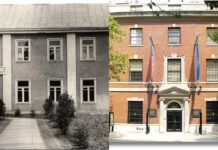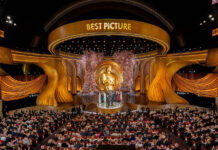Funded and founded by evangelicals, the new Museum of the Bible sticks out for something its leaders clearly wanted to emphasize: Jews.
The eight-story, cutting-edge $500 million institution, which opened last month and is already one of the world’s largest Bible museums, devotes more space to stories of the Hebrew Bible (Jewish texts) than to the New Testament (the part of the Christian canon featuring Jesus and his teachings), highlights a special permanent exhibit on Israeli antiquities, sells Jewish items in its gift shop like menorahs and mezzuzahs, and pipes the sound of people praying in Hebrew through its speakers. A real, live yarmulke-wearing rabbi from Israel is seated at the end of the final major exhibit, writing the letters of a Torah scroll, deliberately there to emphasize museum leaders’ perspective that “God started with the Jewish people, and he is still with the Jewish people,” said Cary Summers, the museum’s president.
Then why do some Jews express skepticism about the museum?
The answer blends politics, culture, theology and the question of whether it’s possible for disparate groups to ever share the Bible in a meaningful way. While modern liberal rhetoric aspires to religious pluralism, the reality is that Christians and Jews see the Bible in fundamentally different ways – from what counts as “the Bible” to how to read and understand it. Not to mention the significant differences within faith groups.
Shmuel Herzfeld, a modern Orthodox rabbi who leads the Ohev Shalom synagogue in Washington, wanted to go weeks ago, when the museum opened, but members of his study group weren’t willing. He finally went alone last week and said he felt awed and a bit weird walking through a bustling museum that to him seemed more about Jews than for them.
He noticed a stack of Star of Davids placed in the gift shop next to statues of a girl in what appear to be God’s hands – which was jarring to Herzfeld since Jews avoid statues, idols or images of anything Godlike. He felt uncomfortable watching the experiential, Disney-like “Jewish Bible” show, much of which is told through impressionistic video. That it was presented without noting the post-biblical Talmud and other rabbinical commentary Jews consider crucial parts of their canon seemed to him to imply that God’s story continues through Christianity – not Judaism. He shook his head as the show depicted Abraham kneeling before God – an image much more in keeping with Christian than Jewish prayer.
“You’re seeing the Bible the way Christians do,” he said of the museum.
“I don’t want to sound cranky because they went out of their way to be nice, and certainly we’re not opposed to teaching what Judaism is about. But there is an uneasy feeling that we’re part of this marketing campaign where the point is to convince people of the prophetic message of Christianity,” he said.
A panel at this month’s annual Association for Jewish Studies conference, entitled “the Museum of the Bible As Mediator of Judaism,” included panelists who all agreed that the museum’s “self-description as religiously neutral” was inaccurate, said Mark Leuchter, professor of Hebrew Bible at Temple University and a participant in the panel.
However, while some Jewish visitors said they felt like props, or felt they were being proselytized to, or had concerns about the legality and authenticity of some items (Hobby Lobby, a craft chain whose owners founded the museum, paid a $3 million fine this summer for smuggling ancient Iraqi artifacts), other Jews are happy with the museum.
The museum collaborated with a number of paid Jewish consultants – including Bible scholars, community advocates and rabbis. The consultants sit on an international advisory board or are expert guides. The Museum’s director of content, Seth Pollinger, said 35 to 40 percent of the board and of the guides are Jewish, a dramatic number when you consider Jews are less than 2 percent of the adult U.S. population, according to the Pew Research Center (and less than a half of 1 percent, worldwide, Pew says).
The consultants lean to the more Orthodox side (which represent about 10 percent of U.S. Jews), but the list also includes people from across the religious and ideological spectrum.
“We are pursuing exhibits that present balanced descriptions that highlight broad consensus views . . . without taking up causes for the ‘religious right’ or the ‘political left.’ Although this is our goal, we will need to constantly host discussions that are open to critical and constructive suggestions on points to improve so we can advance a more ‘centrist’ presentation,” Pollinger wrote in an email.
Among the consultants was prominent Brandeis University historian Jonathan Sarna, whose specialty is American Judaism. He hasn’t yet toured the museum but reviewed the museum exhibit wording in detail for curators.
Sarna said the museum officials did the best they could, but there’s no escaping that the Christian Bible is organized in a way that anticipates the coming of Jesus, while the Hebrew Bible (the older part, often called the Old Testament by non-Jews) is organized differently and does not. Some Jewish visitors felt the museum’s main storytelling exhibit – the “narrative” floor – emphasized the Christian version of the shared stories, such as highlighting Ruth – someone Christians see as a foremother of Jesus – and not Sinai, an essential spot for Jewish understanding of the Bible.
“The Bible is really almost a Rorschach test, people see different things in it. At its best the museum does reflect that. In other places it more reflects the Bible as seen by the funders of the museum,” Sarna said.
There are endless ways to see both the Jewish and Christian traditions, but one core difference is that many Christians see the Bible itself as the highest authority. Jews typically see the Bible as a starting point, to be read and translated through the lens of centuries of rabbinical commentary. This is one reason Sarna thinks most Jews aren’t rushing to the museum – they don’t focus on the Bible.
“When someone from my congregation says: ‘I’m reading the Bible,’ I get worried,” half-joked Stuart Weinblatt, a rabbi from Potomac, Maryland, who spoke at the museum’s dedication and who thinks it’s wonderful. “I say: ‘Just make sure you read it with a Jewish commentary.’ That’s the filter that makes it Jewish.”
Weinblatt said the grand, huge museum is an opportunity for Jews to engage with biblical texts and to find a common ground with others.
Many Jews are wary of evangelical interest, Weinblatt said, because they think it’s motivated primarily by a desire to convert them. While the need for conversion to Christ remains a basic tenet of evangelicalism, many evangelicals today express a more general commitment to the idea that God in the Bible promised to “bless those who bless Israel,” and interpret that in various ways.
“There has been a radical change over the past 20, 25 years and the Jewish community hasn’t woken up,” Weinblatt said.
Weinblatt is touching on a reality: There are key cultural and political challenges in making evangelical Christians and Jews genuine partners. While Orthodox Jews work often with conservative evangelicals on social issues like opposing same-sex marriage, securing public funding for religious private schools and on their shared idea of how to support Israel, the typical American evangelical and the typical American Jew are on opposing sides of many issues in America.
In research released earlier this year, Pew analyzed religious groups’ feelings toward one another. White evangelicals ranked Jews more “warmly” than they did almost any other group, while Jews ranked white evangelicals near the bottom.
Rabbi Scott Perlo of Sixth and I, a D.C. nondenominational synagogue focused on younger Jews, said he hasn’t seen the museum yet but is planning to go soon.
“The proximity to the Mall makes us worried. Because the combination of church and state hasn’t worked out well for the Jews. It feels like a statement is being made about American government and we do not know how to interpret that, what that will lead to,” he said.
American Jews are far more liberal than the American public, particularly on social issues and on the ideal size of government. The museum’s board is almost entirely evangelical, a group that falls on the opposite side of such issues. One of the primary donors to the museum is Hobby Lobby, which sued – and beat – the Obama administration at the Supreme Court after objecting to providing certain types of birth control for employees. The case for many attached conservative political associations onto Hobby Lobby, whose president, Steve Green, is chairman of the museum’s board. His father, Hobby Lobby’s billionaire founder, David Green, wrote an op-ed endorsing Trump for president.
Evangelicals’ tendency to view scripture as orthodox and unchanging clashes with the perspective of most Jews. Pew Research Center found 55 percent of evangelical Protestants said scripture should be taken literally, compared with 11 percent of Jews who said the same.
There are points where museum staff sought to accommodate beliefs shared by the museum’s conservative Christian leaders and their Orthodox Jewish advisers – beliefs not necessarily widely shared by Jews, said Gordon Campbell, an expert on the King James Bible who is on the museum’s advisory board. For example, there is an exhibit on the history floor about early writing, he said, which is meant in part to honor the perspective of more literal believers that the Torah was written very early – perhaps, one could say, by Moses, inspired by God. Mainstream academics date it nearly a millennium later, he said.
The museum worked hard to make Jews comfortable in the museum, Campbell said – for example, taking care to focus on major Protestant figure Martin Luther – a raging anti-Semite – as a Bible translator rather than as a hero.
Summers, the museum president, disagreed with the premise that Jews are staying away and said museum staff reports hearing that visitors regularly include Jews. He said the museum’s main challenge is the months of articles in the run-up to the opening expressing skepticism about the intentions of the institution. The initial mission statement of the museum talked about promoting the literal word of God.
A day after his visit, Herzfeld was still mulling his sentiments about the museum.
“You get a little children’s version of the Bible, which might be good for some, but that’s not to me why it’s meaningful. It’s the interpretation, Jews believe . . . and literalism is often the opposite of the rabbinical tradition,” he said, describing himself as “uneasy . . . I’m still thinking about it all.”


























